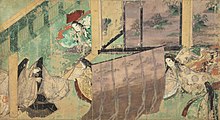

Illustrated handscrolls, emakimono (絵巻物, lit. 'illustrated scroll', also emaki-mono), or emaki (絵巻) is an illustrated horizontal narration system of painted handscrolls that dates back to Nara-period (710–794 CE) Japan. Initially copying their much older Chinese counterparts in style, during the succeeding Heian (794–1185) and Kamakura periods (1185–1333), Japanese emakimono developed their own distinct style. The term therefore refers only to Japanese painted narrative scrolls.
As in the Chinese and Korean scrolls, emakimono combine calligraphy and illustrations and are painted, drawn or stamped on long rolls of paper or silk sometimes measuring several metres. The reader unwinds each scroll little by little, revealing the story as seen fit. Emakimono are therefore a narrative genre similar to the book, developing romantic or epic stories, or illustrating religious texts and legends. Fully anchored in the yamato-e style, these Japanese works are above all an everyday art, centered on the human being and the sensations conveyed by the artist.
Although the very first 8th-century emakimono were copies of Chinese works, emakimono of Japanese taste appeared from the 10th century in the Heian imperial court, especially among aristocratic ladies with refined and reclusive lives, who devoted themselves to the arts, poetry, painting, calligraphy and literature. However, no emakimono remain from the Heian period, and the oldest masterpieces date back to the "golden age" of emakimono in the 12th and 13th centuries. During this period, the techniques of composition became highly accomplished, and the subjects were even more varied than before, dealing with history, religion, romances, and other famous tales. The patrons who sponsored the creation of these emakimono were above all the aristocrats and Buddhist temples. From the 14th century, the emakimono genre became more marginal, giving way to new movements born mainly from Zen Buddhism.
Emakimono paintings mostly belong to the yamato-e style, characterized by its subjects from Japanese life and landscapes, the staging of the human, and an emphasis on rich colours and a decorative appearance. The format of the emakimono, long scrolls of limited height, requires the solving of all kinds of composition problems: it is first necessary to make the transitions between the different scenes that accompany the story, to choose a point of view that reflects the narration, and to create a rhythm that best expresses the feelings and emotions of the moment. In general, there are thus two main categories of emakimono: those which alternate the calligraphy and the image, each new painting illustrating the preceding text, and those which present continuous paintings, not interrupted by the text, where various technical measures allow the fluid transitions between the scenes.
Today, emakimono offer a unique historical glimpse into the life and customs of Japanese people, of all social classes and all ages, during the early part of medieval times. Few of the scrolls have survived intact, and around 20 are protected as National Treasures of Japan.